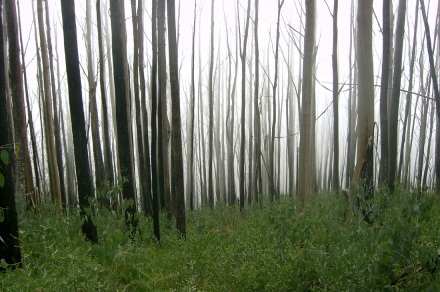
The models created in my research suggest increased seedling elevations and densities are influenced by fire. Dendrochronological studies indicate that large fires in Victorian alpine environments have occurred every 50 – 100 years over the past 400 years. However, under climate change scenarios modeled to the year 2100, fire weather in south-eastern Australia has been predicted to become more frequent and more severe. As fire frequencies increase, the models predict that treeline elevation and density changes will quicken.
However, optimal tree ages that influence seedling establishment as calculated as part of my research were found to be between 24 and 42 years of age. If climate change subsequently reduces fire frequencies to less than (for example) every 20 years, then seedling numbers may actually fall. Repeat burn times that outpace Eucalyptus pauciflora reaching their optimal reproductive maturity age may subsequently have dramatic effects on the Victorian treeline.
The treeline ecotone changes predicted by my research have significant land management implications that should be considered. In particular, the Victorian treeline physiognomy is modeled to become denser under increasing fire frequency due to climate change. Researchers predict that there is a strong relationship between the density of a forest, and the ecosystem services it provides. Increased tree density has been shown to negatively impact habitat quality resulting in trees that are less suitable for food resources, foraging areas, and shelter.
These denser treelines have been shown to be more susceptible to wildfire due to providing additional fuel loads and imposing increased water stress. Fire management in the Australian Alps is recognised as an important strategy to promote natural diversity of the treeline ecotone by application of ecologically suitable fire regimes. Forest management techniques such as tree thinning has also shown to be beneficial to the long term forest structure by reducing fire risk whilst simultaneously improving forest ecosystem services and habitat quality.
Under increased fire frequency and severity scenarios, future changes to the treeline ecotone predicted by my research will require dedicated management to address habitat concerns and wildfire control to ensure alpine conservation is maintained.
